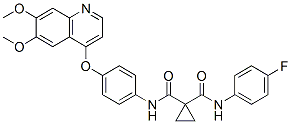All AbMole products are for research use only, cannot be used for human consumption.

Cabozantinib (XL184, BMS-907351) is a small molecule designed to inhibit multiple receptor tyrosine kinases, specifically MET and VEGFR2. MET is a receptor tyrosine kinase that plays key roles in cellular proliferation, migration, and invasion as well as angiogenesis. These biological processes contribute to the transformation, progression, survival and metastasis of cancer cells. The MET pathway is frequently activated in tumors through MET amplification, mutation, and overexpression, as well as through overexpression of its ligand HGF. Expression of VEGF has been observed in a variety of cancers and has been associated with the stimulation and growth of new blood vessels to support the tumor. MET and VEGFR2 are important driving forces in angiogenesis, implicated in the ability of tumors to overcome hypoxia following angiogenesis inhibition.

Cell. 2024 Jul 01.
Amplification editing enables efficient and precise duplication of DNA from short sequence to megabase and chromosomal scale
XL-184 purchased from AbMole

PLoS One. 2022 Sep 15;17(9):e0274620.
Electroacupuncture attenuates ischemic injury after stroke and promotes angiogenesis via activation of EPO mediated Src and VEGF signaling pathways
XL-184 purchased from AbMole

J Virol. 2020 Feb 14;94(5):e01791-19.
Targeting Kaposi's Sarcoma-Associated Herpesvirus ORF21 Tyrosine Kinase and Viral Lytic Reactivation by Tyrosine Kinase Inhibitors Approved for Clinical Use
XL-184 purchased from AbMole
| Cell Experiment | |
|---|---|
| Cell lines | ST-88, STS26T and MPNST724 cells line |
| Preparation method | Cell growth assays MTS assays: these were conducted using CellTiter96 Aqueous Non-Radioactive Cell Proliferation Assay kit (Promega Corp, Madison, WI), per manufacturer's instructions. Drugs were administered at doses and for intervals as indicated. Absorbance was measured at a wavelength of 490 nm, and the absorbance values of treated cells are presented as a percentage of the absorbance of untreated cells. Colony formation assay: one hundred viable cells per well were plated and allowed to grow in normal medium for 10 days and then stained for 30 min at room temperature with a 6% glutaraldehyde, 0.5% crystal violet solution. Pictures were captured digitally and colonies were counted. All experiments were repeated at a minimum twice for each cell line. |
| Concentrations | 0~10 µ M |
| Incubation time | 48 h |
| Animal Experiment | |
|---|---|
| Animal models | SCID mice bearing STS26T and MPNST724 xenografts |
| Formulation | not mentioned |
| Dosages | 30mg/kg/d |
| Administration | gavage |
| Molecular Weight | 501.51 |
| Formula | C28H24FN3O5 |
| CAS Number | 849217-68-1 |
| Solubility (25°C) | DMSO 70 mg/mL |
| Storage | 2-8°C, protect from light |
| Related c-Met Products |
|---|
| Zurletrectinib
Zurletrectinib (ICP-723) is a potent tyrosine kinase inhibitor. Zurletrectinib serves as an antineoplastic agent. Zurletrectinib can used for research of TRK-mediated related diseases. |
| ABN401
ABN401 is a highly potent and selective ATP-competitive c-MET inhibitor with an IC50 value of 10 nM. |
| (Z)-Semaxanib
(Z)-Semaxanib is a potent tyrosine kinase inhibitor. |
| MET kinase-IN-2
MET kinase-IN-2 is a potent, selective, orally bioavailable MET kinase inhibitor with an IC50 of 7.4 nM. |
| BMS-817378
BMS-817378 is a potent and selective inhibitor of MET with IC50 of 1.7 nM. |
All AbMole products are for research use only, cannot be used for human consumption or veterinary use. We do not provide products or services to individuals. Please comply with the intended use and do not use AbMole products for any other purpose.


Products are for research use only. Not for human use. We do not sell to patients.
© Copyright 2010-2024 AbMole BioScience. All Rights Reserved.
